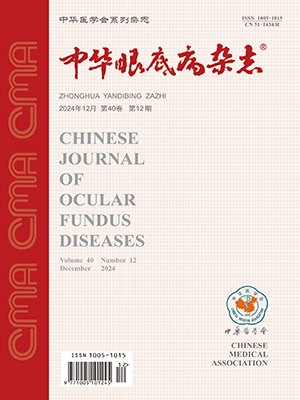| 1. |
Gass JD. Lamellar macular hole: a complication of cystoid macular edema after cataract extraction[J]. Arch Ophthalmol, 1976, 94(5): 793-800. DOI: 10.1001/archopht.1976.03910030391008.
|
| 2. |
Witkin AJ, Ko TH, Fujimoto JG, et al. Redefining lamellar holes and the vitreomacular interface: an ultrahigh-resolution optical coherence tomography study[J]. Ophthalmology, 2006, 113(3): 388-397. DOI: 10.1016/j.ophtha.2005.10.047.
|
| 3. |
Pang CE, Spaide RF, Freund KB. Epiretinal proliferation seen in association with lamellar macular holes: a distinct clinical entity[J]. Retina, 2014, 34(8): 1513-1523. DOI: 10.1097/IAE.0000000000000163.
|
| 4. |
Govetto A, Dacquay Y, Farajzadeh M, et al. Lamellar macular hole: two distinct clinical entities?[J]. Am J Ophthalmol, 2016, 164: 99-109. DOI: 10.1016/j.ajo.2016.02.008.
|
| 5. |
Duker JS, Kaiser PK, Binder S, et al. The International Vitreomacular Traction Study Group classification of vitreomacular adhesion, traction, and macular hole[J]. Ophthalmology, 2013, 120(12): 2611-2619. DOI: 10.1016/j.ophtha.2013.07.042.
|
| 6. |
Ko J, Kim GA, Lee SC, et al. Surgical outcomes of lamellar macular holes with and without lamellar hole-associated epiretinal proliferation[J]. Acta Ophthalmol, 2017, 95(3): 221-226. DOI: 10.1111/aos.13245.
|
| 7. |
Chung H, Lee K, Hwang DJ, et al. Prediction of morphologic deterioration in patients with lamellar macular holes[J]. Retina, 2016, 36(9): 1699-1706. DOI: 10.1097/IAE.0000000000000997.
|
| 8. |
Coassin M, Mastrofilippo V, Stewart JM, et al. Lamellar macular holes: surgical outcome of 106 patients with long-term follow-up[J]. Graefe’s Arch Clin Exp Ophthalmol, 2018, 256(7): 1265-1273. DOI: 10.1007/s00417-018-3989-6.
|
| 9. |
Purtskhvanidze K, Balken L, Hamann T, et al. Long-term follow-up of lamellar macular holes and pseudoholes over at least 5 years[J]. Graefe’s Arch Clin Exp Ophthalmol, 2018, 256(6): 1067-1078. DOI: 10.1007/s00417-018-3972-2.
|
| 10. |
Bottoni F, Deiro AP, Giani A, et al. The natural history of lamellar macular holes: a spectral domain optical coherence tomography study[J]. Graefe’s Arch Clin Exp Ophthalmol, 2013, 251(2): 467-475. DOI: 10.1007/s00417-012-2044-2.
|
| 11. |
Pang CE, Spaide RF, Freund KB. Comparing functional and morphologic characteristics of lamellar macular holes with and without lamellar hole-associated epiretinal proliferation[J]. Retina, 2015, 35(4): 720-726. DOI: 10.1097/IAE.0000000000000390.
|
| 12. |
Schumann RG, Compera D, Schaumberger MM, et al. Epiretinal membrane characteristics correlate with photoreceptor layer defects in lamellar macular holes and macular pseudoholes[J]. Retina, 2015, 35(4): 727-735. DOI: 10.1097/IAE.0000000000000375.
|
| 13. |
Sun JP, Chen SN, Chuang CC, et al. Surgical treatment of lamellar macular hole secondary to epiretinal membrane[J]. Graefe’s Arch Clin Exp Ophthalmol, 2013, 251(12): 2681-2688. DOI: 10.1007/s00417-013-2364-x.
|
| 14. |
Papadopoulou D, Donati G, Mangioris G, et ak. Anatomical and functional results of lamellar macular holes surgery[J]. Klin Monbl Augenheilkd, 2016, 233(4): 441-443. DOI: 10.1055/s-0041-111822.
|
| 15. |
Spaide RF. "Dissociated optic nerve fiber layer appearance" after internal limiting membrane removal is inner retinal dimpling[J]. Retina, 2012, 32(9): 1719-1726. DOI: 10.1097/IAE.0b013e3182671191.
|
| 16. |
Runkle AP, Srivastava SK, Yuan A, et al. Factors associated with development of dissociated optic nerve fiber layer appearance in the pioneer intraoperative optical coherence tomography study[J]. Retina, 2018, 38(Suppl 1): S103-109. DOI: 10.1097/IAE.0000000000002017.
|
| 17. |
Morescalchi F, Russo A, Gambicorti E, et al. Peeling of the internal limiting membrane with foveal sparing for treatment of degenerative lamellar macular hole[J/OL]. Retina, 2019, 2019: E1 [2019-05-16]. https://insights.ovid.com/crossref?an=00006982-900000000-96130. DOI: 10.1097/IAE.0000000000002559.[published online ahead of print].
|




